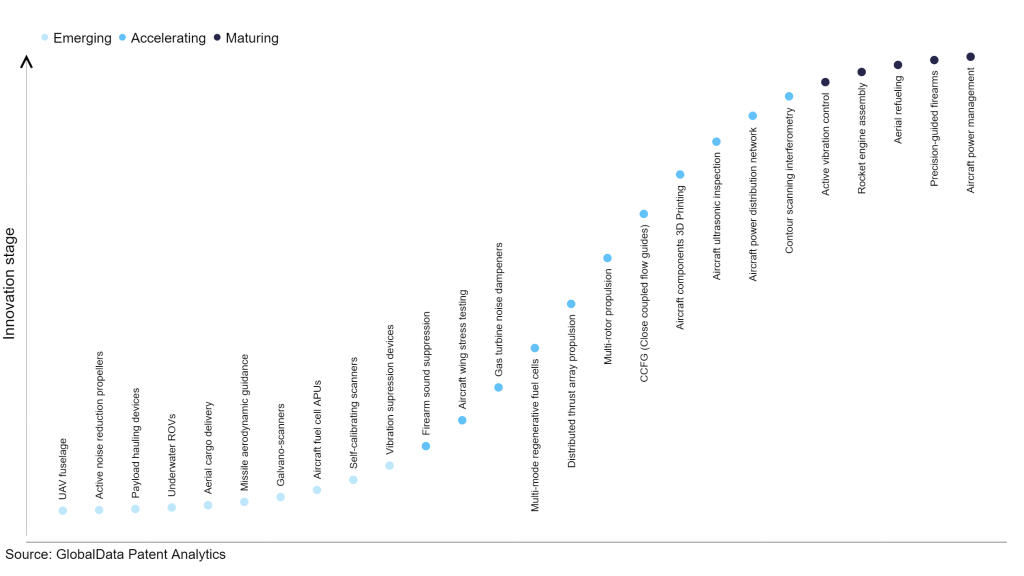The aerospace and defense industry continues to be a hotbed of patent innovation. Activity is driven by automation, environmental sustainability, and operational efficiency, and growing importance of technologies such as artificial intelligence (AI), Internet of Things (IoT), drones, and satellites. In the last three years alone, there have been over 237,000 patents filed and granted in the aerospace and defense industry, according to GlobalData’s report on Innovation in defense: close coupled flow guides (CCFG). Buy the report here.
However, not all innovations are equal and nor do they follow a constant upward trend. Instead, their evolution takes the form of an S-shaped curve that reflects their typical lifecycle from early emergence to accelerating adoption, before finally stabilizing and reaching maturity.
Identifying where a particular innovation is on this journey, especially those that are in the emerging and accelerating stages, is essential for understanding their current level of adoption and the likely future trajectory and impact they will have.
110 innovations will shape the aerospace and defense industry
According to GlobalData’s Technology Foresights, which plots the S-curve for the aerospace and defense industry using innovation intensity models built on over 206,000 patents, there are 110 innovation areas that will shape the future of the industry.
Within the emerging innovation stage, aircraft fuel cell APUs, self-calibrating scanners, and vibration supression devices are disruptive technologies that are in the early stages of application and should be tracked closely. Aircraft ultrasonic inspection, aircraft power distribution network, and contour scanning interferometry are some of the accelerating innovation areas, where adoption has been steadily increasing. Among maturing innovation areas are precision-guided firearms and aircraft power management, which are now well established in the industry.
Innovation S-curve for the aerospace and defense industry

Close coupled flow guides (CCFG) is a key innovation area in aerospace and defense
Close-coupled flow guides are components used in various fluid handling systems, particularly in the context of pumps and hydraulic systems. They play a crucial role in directing and controlling the flow of liquids.
GlobalData’s analysis also uncovers the companies at the forefront of each innovation area and assesses the potential reach and impact of their patenting activity across different applications and geographies. According to GlobalData, there are 80+ companies, spanning technology vendors, established aerospace and defense companies, and up-and-coming start-ups engaged in the development and application of close coupled flow guides.
Key players in close coupled flow guides (CCFG) – a disruptive innovation in the aerospace and defense industry
‘Application diversity’ measures the number of applications identified for each patent. It broadly splits companies into either ‘niche’ or ‘diversified’ innovators.
‘Geographic reach’ refers to the number of countries each patent is registered in. It reflects the breadth of geographic application intended, ranging from ‘global’ to ‘local’.
Patent volumes related to close coupled flow guides
Source: GlobalData Patent Analytics
Safran is one of the leading patent filers in CCFG. It filed patents related to centrifugal impeller for a compressor, method of adapting the air flow of a turbine engine having a centrifugal compressor and diffuser, radial or mixed-flow compressor diffuser having vanes, diffuser having blades with apertures, and diffuser fin of a radial or mixed compressor.
The company offers a wide range of fuel management systems and aerial refueling solutions, including Ram-air turbines for fighter and military transport aircraft. They are adaptable to several platforms. Safran’s aerial refueling connectors offer various flow rates and can be fitted on airplanes or helicopters.
The refueling pumps provided by the company are designed to pressurize fuel fluid through mechanical power to transfer it to the target aircraft during refueling operations. These pumps feature a vital re-priming function, especially in situations where a decrease in fuel level might lead to the tank drying out.
Some other key patent filers in this space include Rolls-Royce, Hanwha Aerospace, and Boeing.
In terms of application diversity, Toshiba, General Electric, and Safran are some of the leading innovators. By means of geographic reach, some of the leading patent filers include Mitsubishi Electric, Samsung, and Toshiba.
To further understand the key themes and technologies disrupting the aerospace and defense industry, access GlobalData’s latest thematic research report on Aerospace & Defense.
Data Insights
From

The gold standard of business intelligence.
Blending expert knowledge with cutting-edge technology, GlobalData’s unrivalled proprietary data will enable you to decode what’s happening in your market. You can make better informed decisions and gain a future-proof advantage over your competitors.



